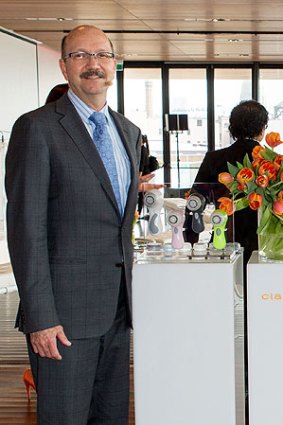This was published 11 years ago
The changing face of spot fixing
Sonic device to clear acne has taken US by storm and made millions for its inventors.
By Natasha Hughes
Robb Akridge doesn't look much like a multi-millionaire. He's fiftyish and modestly besuited in grey, with a receding hairline and the guileless air of an honest-to-goodness American citizen.
He's very nice, very ordinary looking, with a pleasant smile. But look a little more closely and you'll notice his remarkably clear, fine-textured complexion. And is that something throbbing in his hand?

Dr Robb Akridge has been the public face of acne treatment Clarisonic, which has racked up more than $100 million in sales in the US.
Akridge is extraordinary. He is one of five geeks from Seattle who invented a pulsating device that has revolutionised skincare in the US and made them a fortune in the process.
Their vibrating gizmo - the Clarisonic - is now set to change the way Australian men and women clean their faces, too, with the mighty marketing force of its new owner, L'Oreal.
Just don't call it a gadget. "It's a handheld sonic cleansing device that oscillates at a frequency of 300 micro-movements a second," says Akridge. That equates to a clean face in around one minute.
Akridge is known as "Dr Robb" to American television viewers who saw him on Oprah and Ellen and bought the Clarisonic by the truckload after it was launched on the QVC shopping network in 2007.
Within eight hours of Dr Robb's appearance on Oprah the same year, "you couldn't find a Clarisonic in the US," he says. "It took us four months to catch up."
Akridge was in Sydney as part of his two-year condition-of-sale contract to promote the Clarisonic worldwide. A microbiologist with an interest in infectious diseases, he has by default become the face of the brand. The other four inventors, who have backgrounds in engineering, either lacked the communication skills or the desire to travel.
Whatever their social shortcomings, the collective did have the nous and drive to decide on an invention that would make money and then go ahead and build it. And they patented every possible aspect of the Clarisonic - the brush head, the length and material of its fibres, the way it moves on the skin, the way it is attached to the handle - before 10 years later selling their company, Pacific Bioscience Laboratories, to L'Oreal USA in 2011. The previous US financial year, they made net sales worth $105 million.
Seattle - the home of Starbucks, Microsoft and Costco - breeds entrepreneurship, it seems.
"Scientists don't make a lot of money and we wanted to do something to boost our retirement funds," says Akridge, now 56, of his old workmates. "And there was a huge market for solutions to acne."
They all threw in what they could. Akridge said he mortgaged his house to put in just one-tenth of the amount of David Giuliani, the unofficial team leader and later chief executive of the company. Giuliani had sold his Sonicare sonic toothbrush technology to Philips and was seeking a new challenge.
A year of experiments followed, mainly in Akridge's garage. Picture five middle-aged men in lab coats hunched over incubators and wielding oddly shaped wirehead prototype brushes. They first patented LED (light) technology for treating acne before choosing to instead expand the sonic technology they were familiar with.
In doing so, a new category of skincare was born. "The frequency range had to be found - above would be too aggressive on the skin and below doesn't do anything," Akridge says with the passion of a creator. "It feels like a massage, a vibration on the skin. The rapid movement means better cleansing than with cleanser and water - it's like a hose to the pores."
The Clarisonic is almost ubiquitous in the US, where it is sold with every brand of facewash. Some 3.5 million units - all still assembled in Seattle - were sold in 2012. In Australia, L'Oreal has put Clarisonic into David Jones and Myer at the same retail price as in the US and made it available online.
Alas Australia will not have the professorial showmanship of “Dr Robb" spruiking the product on television. Akridge's visit was fleeting and he plans to return to his long-term partner and fully paid-off home in Seattle to indulge his love of the outdoors when his Clarisonic obligations end in December.
He has made the American dream. A "dirt-poor Texan", Akridge is the product of an alcoholic father who left when he was nine and a Hispanic mother whose support helped him secure a scholarship to college.
Says Akridge: "I'm unsure what's next. I'm going to enjoy what I have."